The Huawei Honor 5X Review: Mid-Range Meets Maturity
by Brandon Chester on February 29, 2016 8:00 AM EST- Posted in
- Smartphones
- Huawei
- Android
- Snapdragon 616
- Honor 5X
GPU Performance
There have been significant increases in smartphone performance over the past few years, and this applies to all segments of the market. While it's not entirely clear what will come after Cortex A53 in the low end and mid range segments - Snapdragon 650 currently skews towards the higher-end of the market - it's a safe bet that CPU performance will continue to improve. GPU performance has also seen improvement, but perhaps not to the same degree as CPU performance. The GPU performance of low end devices isn't quite where I'd like it to be, although hopefully this will change with Snapdragon 415's entry into the market. For the time being, GPU performance is something that separates mid range devices like the Honor 5X with its Adreno 405 GPU from lower end devices like the Moto E and even the Moto G which use Adreno 306.
Since Adreno 405 is very well known by this point, and there are fewer software related factors to influence GPU performance than CPU performance, I'm really not expecting any significant deviation from the performance of other phones with the same GPU. However, with the Honor 5X pushing a 1080p display it is interesting to see how the performance when running at native resolution is impacted when moving from a 720p to 1080p display.
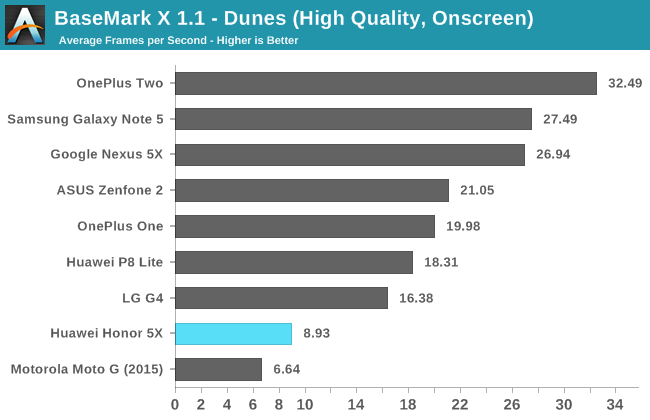
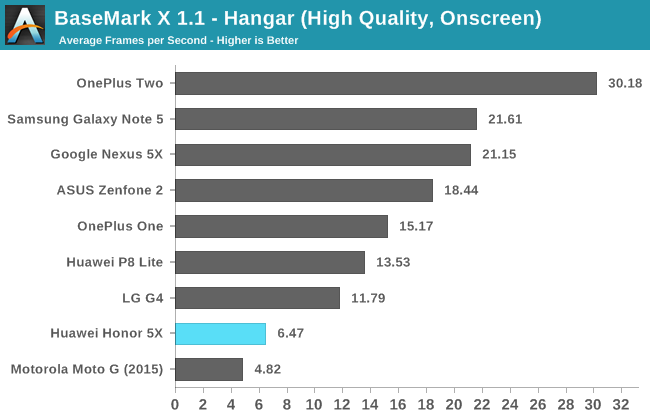
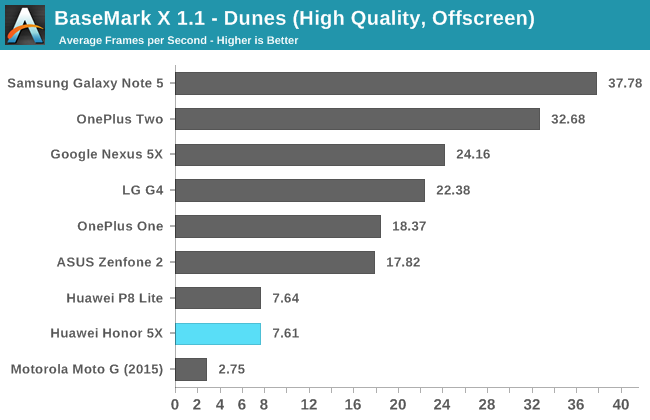
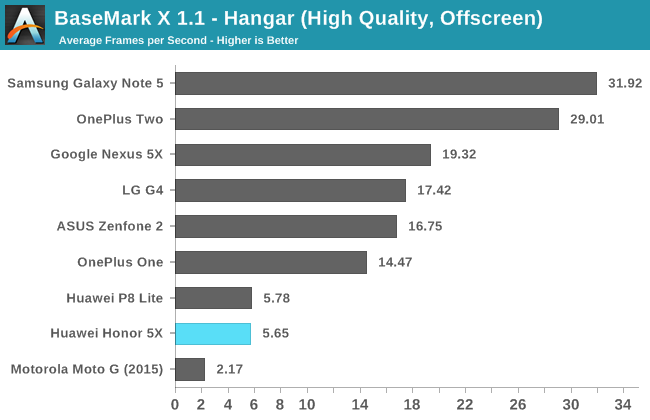
As expected, the Honor 5X tracks extremely closely with the P8 Lite in BaseMark X's off screen tests. Compared to the Moto G which uses Adreno 306 we see that the Honor 5X is roughly 2.7x faster on average, which is a very significant performance improvement.
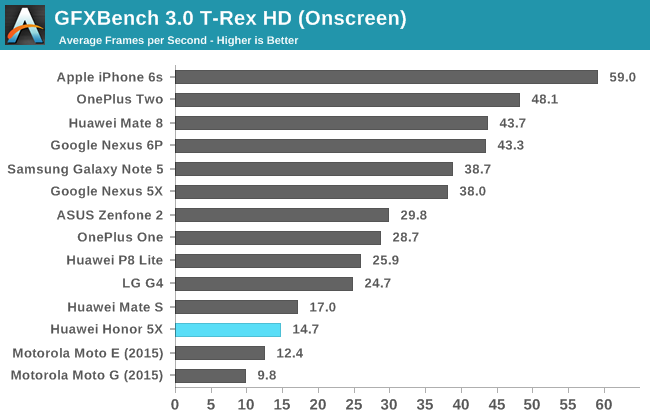
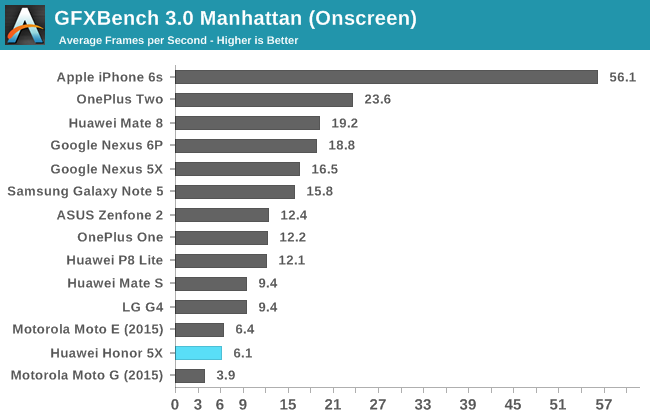

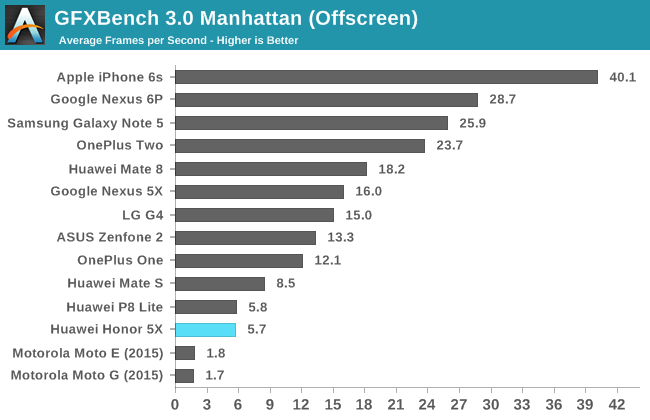
Like the results from BaseMark X, Adreno 405 performs anywhere from 2-3x better than Adreno 305/306 in GFXBench 3.0. On screen results are lower than the P8 Lite due to the Honor 5X's higher resolution display, but off screen results are essentially identical. It's worth noting that T-Rex HD is a pretty old test by now, and these mid range and low end smartphones aren't able to get anywhere close to playable frame rates at their native resolutions. Displays have definitely outpaced GPU improvements in this segment of the market, and it'll take quite a while for the GPUs to catch up.
It's interesting to note that the anomalous ASUS Zenfone 2 is still way more powerful than anything else at $200, including the Honor 5X. However, ASUS's relationship with Intel puts them in a special position, and relative to the average $200 smartphone I think the Honor 5X is about as good as it gets for GPU performance.
NAND Performance
Considering that many high end smartphones haven't moved to UFS or other high performance storage solutions, it's a safe bet that eMMC is going to stick around in mid range and low end smartphones for the foreseeable future. We've already seen how devices shipping with slower storage controllers can be bottlenecked by slow storage performance, and this is an even larger problem among less expensive smartphones where it's just not feasible to include the best NAND solution on the market. Huawei themselves has had issues with NAND performance in the past, and they've improved significantly with recent smartphones, so one would hope that this holds true for the Honor 5X as well.
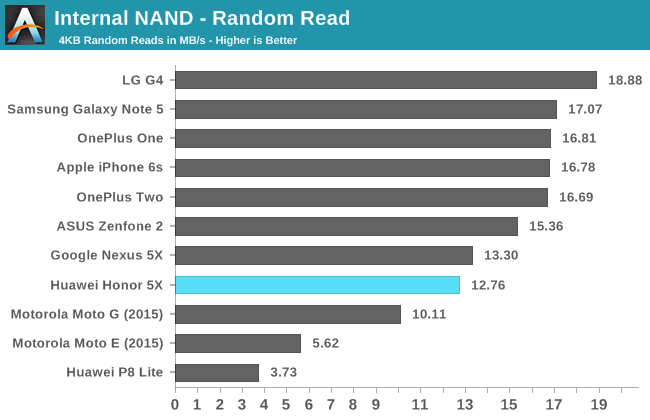
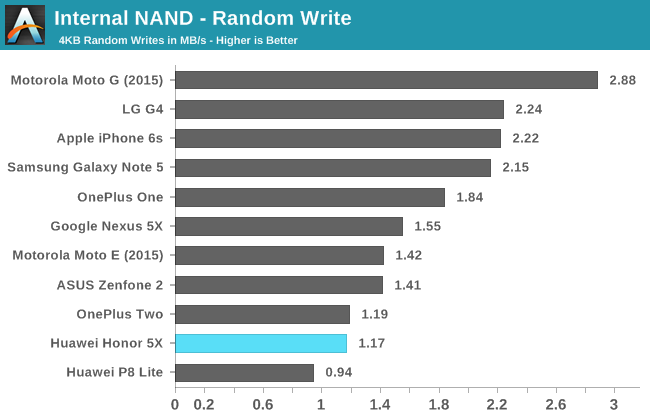
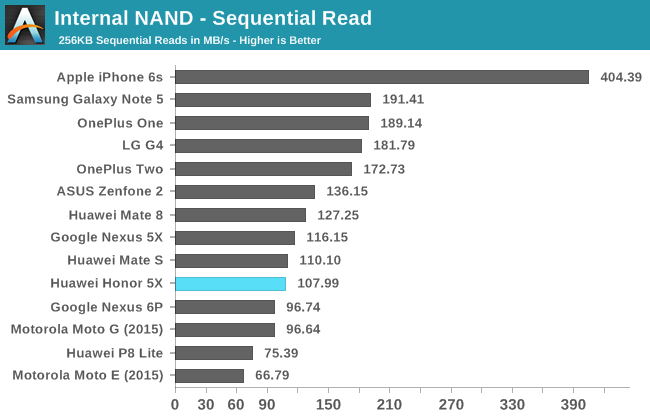
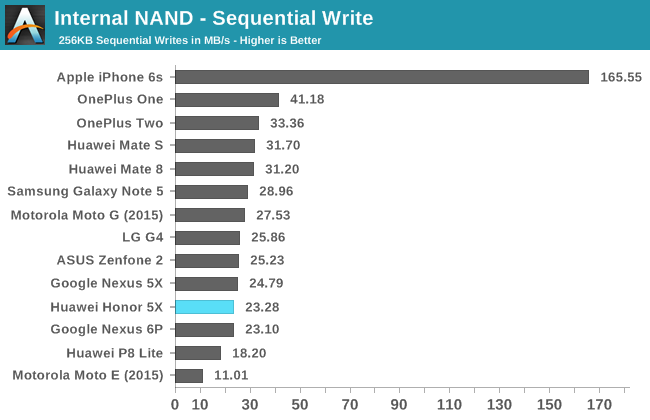
The Honor 5X's NAND performance is in line with what you get from other low end and mid range smartphones. You can't really expect mind blowing NAND performance from these devices, but one can hope that we're at the point where the NAND is fast enough to not be the bottleneck in the system. There's significant improvements across the board compared to the P8 Lite, which is good to see as the P8 Lite performed extremely poorly for a $250 device. I think many of these mid range devices could stand to improve on random write speeds, but that's a more general discussion for another time.










30 Comments
View All Comments
londedoganet - Monday, February 29, 2016 - link
No LTE Web Browsing battery test? Are the bands incompatible?Brandon Chester - Monday, February 29, 2016 - link
I was having difficulties getting sufficient reception due to the weather conditions. The phone has to be placed in a place where it's vulnerable to snow and rain. I'll try to run it at a later point if it's possible.tipoo - Monday, February 29, 2016 - link
Looks like a fair jump over the Moto G for around the same price, nice to see this space heating up. I think the midrange is honestly where the excitement is now, the high end has gotten boring.Though, neither this nor the G are close to taking down the Zenfone 2 for GPU performance yet in the same price category, impressively. I'm unsure if the early issues with the 2 were worked out (battery life, screen color shifting to save power), but for gaming that has both trumped. I'd like to see the Zenfone 3.
blanarahul - Monday, February 29, 2016 - link
If wonder what the real life performance /power differences are between S610 and S615 considering that the extra four cores barely make any difference. Also S610 should be a little cheaper as well.usama_ah - Monday, February 29, 2016 - link
I purchased one from Amazon the day it was released for my mom. Prior to that she was using my OG Moto X on AT&T in Chicago.She's extremely pleased with the phone. There was a slight learning curve going from a near stock launcher to this OS but she loves the big, bright screen and the fingerprint unlock. Camera is good enough for her too. She has noticed the slight UI jankyness while moving about but that's not something she cares about. She uses WhatsApp with family and gets a LOT of pictures and videos so now she doesn't have to delete to make room because she can move them to a microSD card (I set it up to be one button transfer to microSD since WhatsApp doesn't let you default media there). She loves the battery life, and usually charges every other day. She loves the build quality and color (we got her the gold). Works well on AT&T LTE in Chicago and soon she'll be running dual SIM when she goes overseas.
Overall I'm very happy with the purchase, and more importantly she is. It was hard for me to not get her the Moto G but I think we made the right choice, for her. If I was to recommend one to a friend I might still recommend the Moto G first because of customization and flexibility, closer to stock interface. Maybe this year's G will also have a fingerprint reader, we'll see.
zeeBomb - Monday, February 29, 2016 - link
Phone doesn't surprise me due to all the phones I looked at MWC, LOL.Brandon, if you get the chance, review the Alcatel Idol 4!
fanofanand - Monday, February 29, 2016 - link
So it barely beats year old Motorola and Asus phones that sell for the same price. We are impressed because it has a little aluminum? I'd rather a plastic phone with Marshmallow, a better LTE radio, faster ram, and more NAND. This seems like year old specs at the launch, which shouldn't impress anyone.formerglory - Monday, February 29, 2016 - link
Fun fact: the Honor 5X's screen *doesn't* have an oleophobic covering, thus the screen protector that comes with it (that has a coating). Ideally, you're not supposed to remove it, or else suffer the wrath of a constantly fingerprint-covered screen.revanchrist - Monday, February 29, 2016 - link
This is a low end phone priced at mid range price. Man, look at the Snapdragon 616, it's manufactured on 28nm LP. How old was that process already? I'll consider the 28nm HPM Snapdragon 650 and 652 and even the 14nm LPP Snapdragon 625 as mid range, but not the Snapdragon 615 and 616 thanks.beginner99 - Tuesday, March 1, 2016 - link
My though as well. I don't see the midrange except in price. A53's are too slow for midrange and if you really use those, take ones made on 14/16 nm and hence better battery life. The charts clearly show you are better off with a 2 year old flagship.